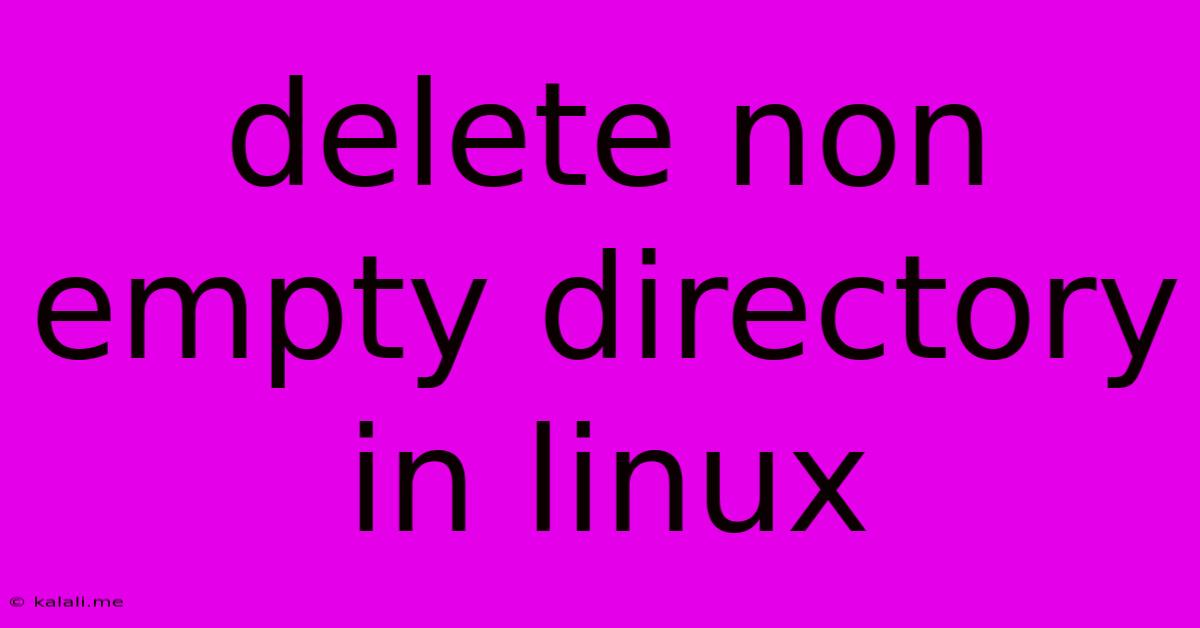Delete Non Empty Directory In Linux
Kalali
May 22, 2025 · 3 min read

Table of Contents
Deleting Non-Empty Directories in Linux: A Comprehensive Guide
Deleting a directory in Linux is a straightforward task if it's empty. However, removing a non-empty directory requires a bit more finesse. This guide explores various methods, highlighting their advantages and disadvantages, so you can choose the best approach for your situation. Understanding these commands will save you time and prevent accidental data loss.
Why Deleting Non-Empty Directories is Trickier
Unlike Windows, Linux doesn't offer a simple "delete" function for non-empty directories. This is a safety feature designed to prevent accidental data loss. Before you can delete a directory, you must first remove its contents. This article will cover several efficient and safe methods to accomplish this.
Method 1: Using rm -r (Recursive Removal)
The rm -r command is the most common way to delete non-empty directories. The -r flag (or -R) stands for "recursive," meaning it will delete the directory and all its contents, including subdirectories and files.
Syntax:
rm -r directory_name
Example:
rm -r my_directory
Caution: This command is powerful and irreversible. Always double-check the directory name before executing this command. There's no undo button! Using rm -rf (force) is extremely dangerous and should be avoided unless you are absolutely certain of what you're doing.
Method 2: Using find and xargs for Selective Deletion
For more granular control, you can use the find command to locate specific files or directories within a larger directory structure and then use xargs to delete them. This is particularly useful if you only want to delete certain types of files or directories within a larger structure, preventing accidental deletion.
Syntax:
find directory_name -type d -exec rm -r {} \;
This command finds all directories (-type d) within directory_name and then recursively removes (rm -r) each one ({}).
Example:
find my_directory -type d -exec rm -r {} \;
This method offers a safer alternative compared to rm -r alone, especially when dealing with complex directory structures.
Method 3: Manually Removing Contents then Deleting the Directory
This is the most cautious and beginner-friendly method. First, you manually remove the contents of the directory, then you delete the empty directory.
- List directory contents: Use the
lscommand to view the files and subdirectories within the target directory. - Remove files and subdirectories: Use
rmfor files andrm -rfor subdirectories individually. This gives you complete control and allows for careful verification. - Delete the empty directory: Once the directory is empty, use
rmdir directory_nameto remove the now-empty directory.
Example:
ls my_directory
rm my_directory/file1.txt
rm -r my_directory/subdir
rmdir my_directory
This method is slower but significantly reduces the risk of accidental data loss.
Best Practices for Deleting Directories
- Always back up important data before attempting any deletion. This is crucial to prevent irreversible data loss.
- Double-check the directory name before executing any delete command. A simple typo can have disastrous consequences.
- Use the
-iflag withrmfor interactive confirmation before each deletion. This prompts you to confirm each deletion, reducing the risk of errors. Example:rm -ri file.txt - Understand the commands thoroughly before using them. Incorrect usage can lead to data loss.
- Consider using a graphical file manager for a more visual and intuitive approach, especially for beginners.
By understanding these methods and following best practices, you can confidently and safely delete non-empty directories in Linux. Remember, prevention is key, so always back up your data and double-check your commands before execution.
Latest Posts
Latest Posts
-
Which Of The Following Is True Concerning A Dao
Jul 02, 2025
-
How Long Can Catfish Live Out Of Water
Jul 02, 2025
-
Is Kanye West Related To Cornel West
Jul 02, 2025
-
Olivia Needs To Provide A Visual Summary
Jul 02, 2025
-
How Many Cups Of Macaroni In A Pound
Jul 02, 2025
Related Post
Thank you for visiting our website which covers about Delete Non Empty Directory In Linux . We hope the information provided has been useful to you. Feel free to contact us if you have any questions or need further assistance. See you next time and don't miss to bookmark.